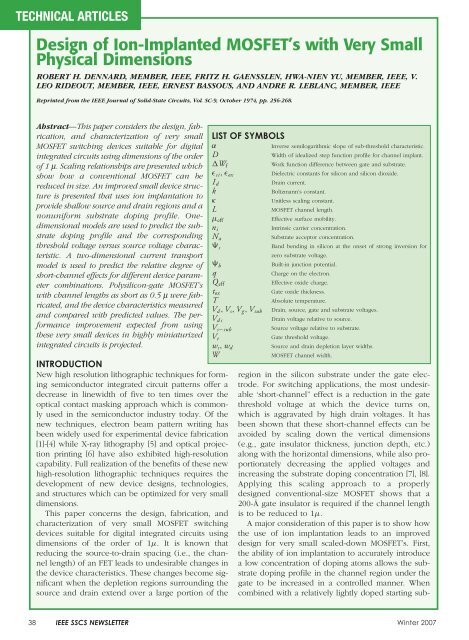The Impact of Dennard's Scaling Theory - IEEE
The Impact of Dennard's Scaling Theory - IEEE
The Impact of Dennard's Scaling Theory - IEEE
- TAGS
- scaling
- www.ieee.org
You also want an ePaper? Increase the reach of your titles
YUMPU automatically turns print PDFs into web optimized ePapers that Google loves.
TECHNICAL ARTICLES<br />
Design <strong>of</strong> Ion-Implanted MOSFET’s with Very Small<br />
Physical Dimensions<br />
ROBERT H. DENNARD, MEMBER, <strong>IEEE</strong>, FRITZ H. GAENSSLEN, HWA-NIEN YU, MEMBER, <strong>IEEE</strong>, V.<br />
LEO RIDEOUT, MEMBER, <strong>IEEE</strong>, ERNEST BASSOUS, AND ANDRE R. LEBLANC, MEMBER, <strong>IEEE</strong><br />
Reprinted from the <strong>IEEE</strong> Journal <strong>of</strong> Solid-State Circuits, Vol. SC-9, October 1974, pp. 256-268.<br />
Abstract—This paper considers the design, fabrication,<br />
and characterization <strong>of</strong> very small<br />
MOSFET switching devices suitable for digital<br />
integrated circuits using dimensions <strong>of</strong> the order<br />
<strong>of</strong> 1 μ. <strong>Scaling</strong> relationships are presented which<br />
show how a conventional MOSFET can be<br />
reduced in size. An improved small device structure<br />
is presented that uses ion implantation to<br />
provide shallow source and drain regions and a<br />
nonuniform substrate doping pr<strong>of</strong>ile. Onedimensional<br />
models are used to predict the substrate<br />
doping pr<strong>of</strong>ile and the corresponding<br />
threshold voltage versus source voltage characteristic.<br />
A two-dimensional current transport<br />
model is used to predict the relative degree <strong>of</strong><br />
short-channel effects for different device parameter<br />
combinations. Polysilicon-gate MOSFET’s<br />
with channel lengths as short as 0.5 μ were fabricated,<br />
and the device characteristics measured<br />
and compared with predicted values. <strong>The</strong> performance<br />
improvement expected from using<br />
these very small devices in highly miniaturized<br />
integrated circuits is projected.<br />
INTRODUCTION<br />
New high resolution lithographic techniques for forming<br />
semiconductor integrated circuit patterns <strong>of</strong>fer a<br />
decrease in linewidth <strong>of</strong> five to ten times over the<br />
optical contact masking approach which is commonly<br />
used in the semiconductor industry today. Of the<br />
new techniques, electron beam pattern writing has<br />
been widely used for experimental device fabrication<br />
[1]-[4] while X-ray lithography [5] and optical projection<br />
printing [6] have also exhibited high-resolution<br />
capability. Full realization <strong>of</strong> the benefits <strong>of</strong> these new<br />
high-resolution lithographic techniques requires the<br />
development <strong>of</strong> new device designs, technologies,<br />
and structures which can be optimized for very small<br />
dimensions.<br />
This paper concerns the design, fabrication, and<br />
characterization <strong>of</strong> very small MOSFET switching<br />
devices suitable for digital integrated circuits using<br />
dimensions <strong>of</strong> the order <strong>of</strong> 1μ. It is known that<br />
reducing the source-to-drain spacing (i.e., the channel<br />
length) <strong>of</strong> an FET leads to undesirable changes in<br />
the device characteristics. <strong>The</strong>se changes become significant<br />
when the depletion regions surrounding the<br />
source and drain extend over a large portion <strong>of</strong> the<br />
LIST OF SYMBOLS<br />
α Inverse semilogarithmic slope <strong>of</strong> sub-threshold characteristic.<br />
D Width <strong>of</strong> idealized step function pr<strong>of</strong>ile for channel implant.<br />
�Wf<br />
Work function difference between gate and substrate.<br />
ɛsi,ɛox<br />
Id<br />
Dielectric constants for silicon and silicon dioxide.<br />
Drain current.<br />
k Boltzmann’s constant.<br />
κ Unitless scaling constant.<br />
L MOSFET channel length.<br />
μeff<br />
Effective surface mobility.<br />
ni<br />
Intrinsic carrier concentration.<br />
Na<br />
Substrate acceptor concentration.<br />
�s<br />
Band bending in silicon at the onset <strong>of</strong> strong inversion for<br />
zero substrate voltage.<br />
�b<br />
Built-in junction potential.<br />
q Charge on the electron.<br />
Q eff<br />
Effective oxide charge.<br />
tox<br />
Gate oxide thickness.<br />
T Absolute temperature.<br />
Vd ,Vs,Vg ,Vsub Drain, source, gate and substrate voltages.<br />
Vds<br />
Drain voltage relative to source.<br />
Vs−sub<br />
Source voltage relative to substrate.<br />
Vt<br />
Gate threshold voltage.<br />
ws, wd<br />
Source and drain depletion layer widths.<br />
W MOSFET channel width.<br />
region in the silicon substrate under the gate electrode.<br />
For switching applications, the most undesirable<br />
‘short-channel” effect is a reduction in the gate<br />
threshold voltage at which the device turns on,<br />
which is aggravated by high drain voltages. It has<br />
been shown that these short-channel effects can be<br />
avoided by scaling down the vertical dimensions<br />
(e.g., gate insulator thickness, junction depth, etc.)<br />
along with the horizontal dimensions, while also proportionately<br />
decreasing the applied voltages and<br />
increasing the substrate doping concentration [7], [8].<br />
Applying this scaling approach to a properly<br />
designed conventional-size MOSFET shows that a<br />
200-Å gate insulator is required if the channel length<br />
is to be reduced to 1μ.<br />
A major consideration <strong>of</strong> this paper is to show how<br />
the use <strong>of</strong> ion implantation leads to an improved<br />
design for very small scaled-down MOSFET’s. First,<br />
the ability <strong>of</strong> ion implantation to accurately introduce<br />
a low concentration <strong>of</strong> doping atoms allows the substrate<br />
doping pr<strong>of</strong>ile in the channel region under the<br />
gate to be increased in a controlled manner. When<br />
combined with a relatively lightly doped starting sub-<br />
38 <strong>IEEE</strong> SSCS NEWSLETTER Winter 2007




